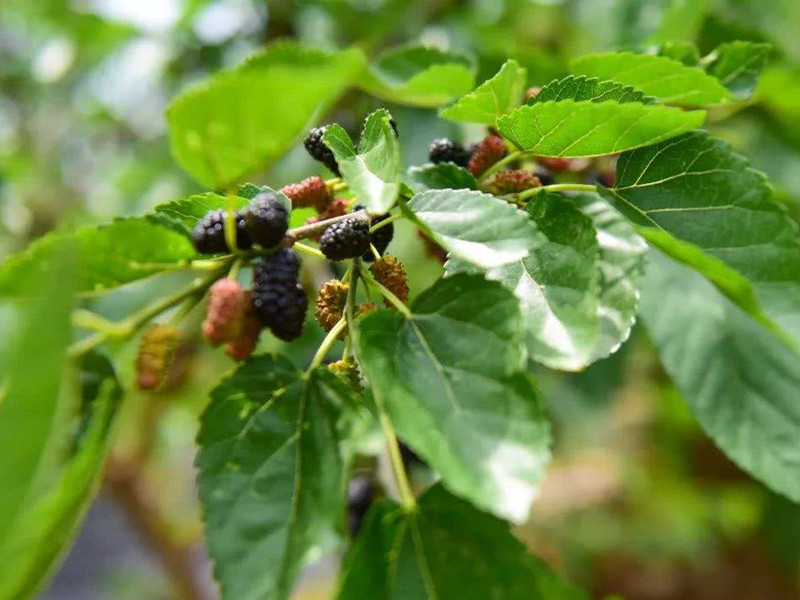Mulberry leaves are the fresh or dried leaves of the Mulberry tree (Morus albaL.) in the Moraceae family and were used to raise silkworms in ancient China. A recent study of mulberry leaf extract demonstrated a significant reduction in the increase in plasma glucose levels after sucrose ingestion. In addition, it also significantly suppressed the increase in total insulin levels in the blood after this same period. In addition, no adverse events were reported by any of the study participants. These findings suggest that mulberry leaf extract may benefit patients with diabetes by promoting healthier blood glucose levels. But what exactly does mulberry leaf extract do? Let’s begin with its chemical compositions and pharmacological activity.
Chemical Compositions Of Mulberry leaves
Flavonoids and flavonoid glycosides
The main active components in mulberry leaves are flavonoids and flavonoid glycosides, accounting for 1% ~ 3% of the content of dry matter, including flavonoids, flavonols, dihydroflavonols and anthocyanins, a total of more than 20 kinds of components. Dry matter mainly contains flavonoids rutin, quercetin, quercetin and isoquercetin. The content of flavonoids was highest in leaf tip and young leaf of mulberry leaf.
Polyphenols
Mulberry leaves contain a lot of polyphenols. Because polyphenols have the chemical structure of hydroxyl oxygen, they can cut off the free radical chain reaction in the body with the help of polyphenol oxidase, and play the role of scavenging free radicals and eliminating their toxicity, thus showing a variety of biological activities such as anti-aging and enhancing immunity. The study found that mulberry leaf polyphenols are composed of p-hydroxycinnamic acid, caffeic acid, chlorogenic acid and its isomer, 7-hydroxycoumarin and other components.
Alkaloids
Japanese scholar Asano et al. extracted seven alkaloids including deoxynojirimycin, N-methyl-DNJ, 2-oxygen -α -D-galactopyranosid-1-DNJ and Fagomine from mulberry leaves. DNJ Powder can inhibit the activity of α -glycosidase and reduce the peak of blood sugar in a short time after eating, thus reducing the absorption rate of sugar in the small intestine.
polysaccharide
Polysaccharide from the mulberry leaf can reduce blood glucose and inhibit the elevation of blood lipids by repairing ISlet B cells and promoting insulin secretion. Influence human growth regulator level. Insulin can affect glucose metabolism, liver glycogen synthesis and cell glucose utilization and finally hypoglycemic effect. The total polysaccharide in mulberry leaves accounted for 1.79% ~ 2.64% of dry matter content in mulberry leaves. Up to now, MP11, MP12, MP13, polysaccharide components ⅰ, ⅱ, ⅲ have been isolated and purified. However, the components of POLYSACCHARIDE in mulberry leaves were SD2-3, SD3-3, SD3-4, MLP1 and MLP2, etc. Due to the complex structure of polysaccharide, the composition and proportion of monosaccharide, the types and residues of glycosidic bonds of some mulberry leaf polysaccharides can only be determined, and the specific structure needs further study.
Phytosterols
Plant sterols, also known as sterols, have a basic structure of cyclopentane perhydrophenanthrene, containing 3-hydroxyl, which not only exist in various vegetable oils, nuts and plant seeds, but also in other plant foods such as fruits and vegetables. The sterol content in mulberry leaves is 3 ~ 4 times higher than that in other plants, and it mainly contains β -sitosterol, β -D-glucoside, stigmasterol and mosquitoes. Phytosterols compete with cholesterol in the chylomicron, leading to the direct absorption of cholesterol into an unabsorbable form that is separated from the chylomicron and cannot penetrate the intestinal wall, thus inhibiting the absorption of cholesterol.
Volatile oil
The volatile oil in mulberry leaves includes acetic acid, propionic acid, butyric acid, valerate acid, caproic acid, isobutyric acid, phenol, guaiacol, o-cresol and m-cresol, etc., and also contains oxalic acid, citric acid, fumaric acid, palmitic acid, tartaric acid, succinic acid, undecane, hydroxylcoumarin and so on.
Amino acids
There are 18 kinds of amino acids in mulberry leaves, accounting for 10.10% of the total dry matter in mulberry leaves, among which the essential amino acid content of human body accounts for 44.85% of the total amino acid. These include glutamate, glycine, valine, alanine, semen, lysine and tyrosine, as well as leucine, isoleucine, cysteine, aspartic acid, phenylalanine, proline and gamma-aminobutyric acid. Glutamate is the highest content of amino acids, but also the precursor of the neurotransmitter γ -aminobutyric acid, which has the function of lowering blood pressure and protecting brain tissue.
Vitamin
Mulberry leaves contain vitamin A, vitamin B group, vitamin C and niacin and other vitamins.
Other ingredients
Mulberry leaves also contain proteins, lipids, carbohydrates, minerals, dietary fiber, organic acids, trace elements and other chemical components.
Benefits of Mulberry Leaves
Lower blood sugar
One study found that white mulberry leaf extract inhibited the activity of sucrase in diabetics and healthy individuals. Another study showed that mulberry leaf extract also reduced A1C levels and lipid peroxidation markers in type 2 diabetes subjects. These results were statistically and clinically significant and suggested that mulberry leaf extract may be beneficial to patients suffering from type 2 diabetes. However, more studies are needed to determine whether mulberry leaf extract has any effect on the body’s ability to regulate blood sugar levels.
Polyhydroxyalkaloid Fagomine (buckwheat alkaloid) in mulberry leaves can promote insulin release and significantly increase insulin content. The results showed that the total polysaccharide in mulberry leaves could increase insulin level while lowering blood glucose. The results showed that when methanol extract of mulberry leaf co-existed, sucrose absorption was inhibited, and the activity of disaccharide decomposition enzyme was inhibited, while the water extract of mulberry leaf inhibited the activity of lactase and maltitoenzyme, and prevented the increase of blood glucose level after eating in rats. It was concluded that deoxynojirimycin could inhibit the activity of α -glycosidase in mulberry leaves. Deoxynojirimycin, also known as DNJ, blocks 50% of the activity of alpha-glycosidase and binds to it in the small intestine. In addition, the affinity between DNJ and α -glycosidase is stronger than that between disaccharide and α -glycosidase, which can not be absorbed and decomposed more deeply, resulting in a significant decrease in blood glucose content. It is confirmed that DNJ is the main component of mulberry leaf which can inhibit α -glycosidase and reduce blood glucose significantly.
The study found that mulberry leaf extract significantly reduced the levels of three key enzymes that are responsible for preventing T2DM. These enzymes include glutathione reductase, glutathione peroxidase, and superoxide dismutase. In addition to its anti-oxidant properties, mulberry leaf extract reduces the level of glucose in the blood and insulin levels, two of the most important factors in preventing diabetes.
Reducing blood fat
The blood of patient with high lipidemia is sticky, and the deposit of low-density lipoprotein, cause capillary to become narrow even jam, easy cause myocardial infarction and cerebral hemorrhage. Studies have shown that flavonoids in mulberry leaves can reduce the contents of serum total cholesterol, triglyceride and low density lipoprotein cholesterol, and increase the content of high-density lipoprotein cholesterol, thus reducing the atherosclerosis index, and significantly improve the activity of SOD, and reducing the level of malondialdehyde. Mulberry leaves also contain a variety of sterols, and almost no cholesterol, stigmasterol and sterol in sterol can prevent cholesterol from being absorbed by the intestinal tract, so as to achieve the purpose of reducing plasma cholesterol and blood lipid level.
Losing weight
A recent study found that mulberry leaf extract inhibits body weight gain induced by a high-fat diet. The final body weight of the animals fed with mulberry leaves was significantly lower than that of the controls. In addition, the volume of visceral adipose tissue and the overall body fat mass were reduced. The findings were also confirmed by microscopic analysis. Similarly, mulberry leaf extract inhibited the production of adipocytes and lipid droplets, which are responsible for fat storage.
Anti-aging
Mulberry leaves contain phenolic compounds and vitamin C and other components can inhibit or remove free radicals, prevent cell damage due to oxidation, and then slow down aging. Vitamin B1 helps maintain the normal function of the heart and nervous system. Vitamin B2 helps maintain the normal function of the retina; Vitamin C can enhance the density of the small blood vessels, enhance the body’s resistance to infection. Folic acid can intervene in the synthesis of nucleic acid, has the effect of resisting all kinds of anemia symptoms and promoting growth, is beneficial to human health. By increasing the activity of antioxidant enzymes such as SOD, flavonoids can eliminate superoxide free radicals and hydroxyl free radicals and prevent protein from transforming into glycosylated end products, which can be used to relieve diabetes and its complications.
Anti-viral
The study found that HIV contains the gp140 and GP120 proteins, both glycosylated, which mediate contact between the virus and receptor molecules on the cell surface to form syncytites. It has been suggested that n-methyl-1-deoxynojirimycin, 1-deoxynojirimycin and their derivatives in the alkaloids of mulberry leaves can inhibit glycoprotein processing and transform GP120 protein glycosylation, and n-butyl-1-deoxynojirimycin can block the formation process of HIV-1-induced syncytic cells.
Anti-tumor
Flavonoids, DNJ, vitamins, Cu-Zn, SOD, GABA and other components contained in mulberry leaves can prevent cancer, enhance the immune capacity of the body, and prevent chromosome mutation. Flavonoids from the mulberry leaf can induce the differentiation of human promyeloid leukemia (HL-60) cells. These flavonoids can scour the free radicals of 1, 1-diphenyl-2-picryl-hydrazine and show inhibitory effect on the growth of human promyeloid leukemia cell lines.
In addition to mulberry leaf extract‘s ability to lower bad cholesterol, it also has a wide range of other benefits that are becoming increasingly recognized in the dietary supplement industry. Among these are the beneficial effects of mulberry on the digestive system, the immune system, and skin lightening. Additionally, there is also a good chance that some components of the plant also have anti-cancer effects. It’s not clear how, exactly, these benefits can be realized in humans, but mulberry leaf extract has already gained significant popularity in the market.
Applications of Mulberry Leaf
In recent years, with the development of a mulberry leaf from raw material processing to mulberry leaf extract supplement, its nutritional and medicinal value has been gradually explored, and it has become popular in the food and medical care fields. The Asia-Pacific region is the largest market for mulberry leaf extract, with China, India, and Japan accounting for the largest share of global production. The European market is also dominated by the dietary supplement sector, which is driven by the whitening effect of mulberry extracts.
Animal feed
Mulberry leaf powder can be used as feed instead of concentrate feed or protein feed. The protein content in mulberry leaves is high, which can obviously improve the color and flavor of chicken yolk and effectively reduce the ammonia emission in chicken manure when added to chicken feed in a certain proportion. Adding 25% ~ 30% to black goat feed or 10% ~ 15% to meat rabbit feed can enhance physique, accelerate growth, improve meat quality and reduce feeding costs at the same time.
Mulberry leaf tea
Mulberry leaf tea is generally made of high-quality young mulberry leaves with good ecological environment, no pollution and no diseases and insect pests. It is refined by twisting, rolling, baking and other processes. The main purpose of this process is to get rid of the bitter taste and grass taste in mulberry leaves. Mulberry leaf tea has the health care effects of lowering blood sugar and blood fat, cholesterol, weight loss and beauty, etc. Besides, it is also suitable for the auxiliary treatment of people with abnormal glucose tolerance, mild diabetes and hyperlipidemia.
- Dandelion Extract: What It Is, Benefits, Uses and Side Effect - April 23, 2024
- Is Berberine Extract Help For Weight Loss? - April 11, 2024
- Why Is Pysllium Husk Powder A Popular Meal Replacement Ingredient? - April 3, 2024



